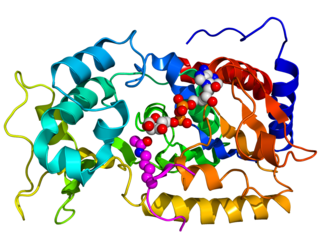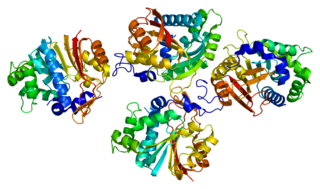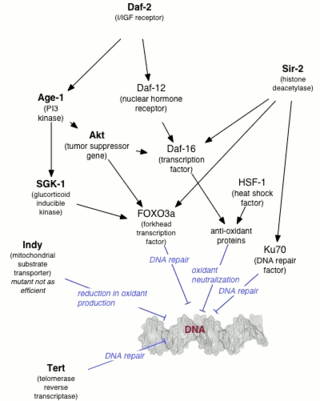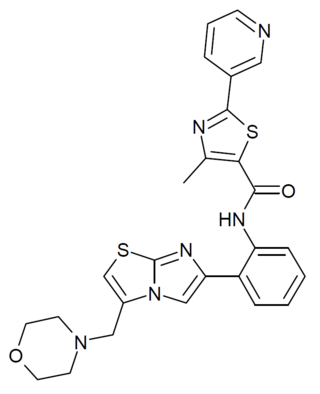Related Research Articles

Nicotinamide adenine dinucleotide (NAD) is a coenzyme central to metabolism. Found in all living cells, NAD is called a dinucleotide because it consists of two nucleotides joined through their phosphate groups. One nucleotide contains an adenine nucleobase and the other, nicotinamide. NAD exists in two forms: an oxidized and reduced form, abbreviated as NAD+ and NADH (H for hydrogen), respectively.
Calorie restriction mimetics (CRM), also known as energy restriction mimetics, are a hypothetical class of dietary supplements or drug candidates that would, in principle, mimic the substantial anti-aging effects that calorie restriction (CR) has on many laboratory animals and humans. CR is defined as a reduction in calorie intake of 20% to 50% without incurring malnutrition or a reduction in essential nutrients. An effective CRM would alter the key metabolic pathways involved in the effects of CR itself, leading to preserved youthful health and longer lifespan without the need to reduce food intake. The term was coined by Lane, Ingram, Roth of the National Institute on Aging in a seminal 1998 paper in the Journal of Anti-Aging Medicine, the forerunner of Rejuvenation Research. A number of genes and pathways have been shown to be involved with the actions of CR in model organisms and these represent attractive targets for drug discovery and for developing CRM. However, no effective CRM have been identified to date.

Sirtuins are a family of signaling proteins involved in metabolic regulation. They are ancient in animal evolution and appear to possess a highly conserved structure throughout all kingdoms of life. Chemically, sirtuins are a class of proteins that possess either mono-ADP-ribosyltransferase or deacylase activity, including deacetylase, desuccinylase, demalonylase, demyristoylase and depalmitoylase activity. The name Sir2 comes from the yeast gene 'silent mating-type information regulation 2', the gene responsible for cellular regulation in yeast.
Leonard Pershing Guarente is an American biologist best known for his research on life span extension in the budding yeast Saccharomyces cerevisiae, roundworms, and mice. He is a Novartis Professor of Biology at the Massachusetts Institute of Technology.

David Andrew Sinclair is an Australian-American biologist and academic known for his research on aging and epigenetics. Sinclair is a professor of genetics at Harvard Medical School and is the co-director of its Paul F. Glenn Center for Biology of Aging Research. He was the president of the non-profit Academy for Health & Lifespan Research until resigning on March 13, 2024.

Nicotinamide phosphoribosyltransferase, formerly known as pre-B-cell colony-enhancing factor 1 (PBEF1) or visfatin for its extracellular form (eNAMPT), is an enzyme that in humans is encoded by the NAMPT gene. The intracellular form of this protein (iNAMPT) is the rate-limiting enzyme in the nicotinamide adenine dinucleotide (NAD+) salvage pathway that converts nicotinamide to nicotinamide mononucleotide (NMN) which is responsible for most of the NAD+ formation in mammals. iNAMPT can also catalyze the synthesis of NMN from phosphoribosyl pyrophosphate (PRPP) when ATP is present. eNAMPT has been reported to be a cytokine (PBEF) that activates TLR4, that promotes B cell maturation, and that inhibits neutrophil apoptosis.

Sirtuin 1, also known as NAD-dependent deacetylase sirtuin-1, is a protein that in humans is encoded by the SIRT1 gene.

Nicotinamide mononucleotide adenylyltransferase 1 (NMNAT1) is an enzyme that in humans is encoded by the nmnat1 gene. It is a member of the nicotinamide-nucleotide adenylyltransferases (NMNATs) which catalyze nicotinamide adenine dinucleotide (NAD) synthesis.

Nicotinamide N-methyltransferase (NNMT) is an enzyme that in humans is encoded by the NNMT gene. NNMT catalyzes the methylation of nicotinamide and similar compounds using the methyl donor S-adenosyl methionine (SAM-e) to produce S-adenosyl-L-homocysteine (SAH) and 1-methylnicotinamide.

Nicotinamide mononucleotide adenylyltransferase 2 (NMNAT2) is an enzyme that in humans is encoded by the NMNAT2 gene.

SRT-1720 is an experimental drug that was studied by Sirtris Pharmaceuticals intended as a small-molecule activator of the sirtuin subtype SIRT1. The compound has been studied in animals, but safety and efficacy in humans have not been established.
Sirtris Pharmaceuticals, Inc. was a biotechnology company based in Cambridge, MA that developed therapies for type 2 diabetes, cancer, and other diseases. Conceived in 2004 by Harvard University biologist David Sinclair and Andrew Perlman, and founded that year by Sinclair and Perlman, along with Christoph Westphal, Richard Aldrich, Richard Pops, and Paul Schimmel, the company was focused on developing Sinclair's research into activators of sirtuins, work that began in the laboratory of Leonard P. Guarente where Sinclair worked as a post-doc before starting his own lab.
Christoph Westphal is an American biomedical businessman.

SRT-2183 is a drug in development by Sirtris Pharmaceuticals intended as a small-molecule activator of the sirtuin subtype SIRT1. It has similar activity in animal studies to another SIRT1 activator SRT-1720, but is closer in potency to resveratrol. In animal studies it was found to improve insulin sensitivity and lower plasma glucose levels in fat, muscle and liver tissue, and increased mitochondrial and metabolic function. However, the claim that SRT-2183 is a SIRT1 activator has been questioned and further defended.

SRT-1460 is a drug in development by Sirtris Pharmaceuticals intended as a small-molecule activator of the sirtuin subtype SIRT1. It has similar activity in animal studies to the known SIRT1 activator resveratrol, but is closer in potency to SRT-1720. In animal studies it was found to improve insulin sensitivity and lower plasma glucose levels in fat, muscle and liver tissue, and increased mitochondrial and metabolic function. However, the claim that SRT1460 is a SIRT1 activator has been questioned and further defended.

Genetics of aging is generally concerned with life extension associated with genetic alterations, rather than with accelerated aging diseases leading to reduction in lifespan.

Nicotinamide riboside (NR, SR647) is a pyridine-nucleoside and a form of vitamin B3. It functions as a precursor to nicotinamide adenine dinucleotide, or NAD+, through a two-step and a three-step pathway.

Nicotinamide mononucleotide is a nucleotide derived from ribose, nicotinamide, nicotinamide riboside and niacin. In humans, several enzymes use NMN to generate nicotinamide adenine dinucleotide (NADH). In mice, it has been proposed that NMN is absorbed via the small intestine within 10 minutes of oral uptake and converted to nicotinamide adenine dinucleotide (NAD+) through the Slc12a8 transporter. However, this observation has been challenged, and the matter remains unsettled.

SRT-2104 is an experimental drug that was studied by Sirtris Pharmaceuticals as a small-molecule activator of the sirtuin subtype SIRT1. The compound progressed to Phase II human trials for Type II diabetes before development was discontinued, however it continues to be widely used in animal research into the functions of SIRT1.

SRT-3025 is an experimental drug that was studied by Sirtris Pharmaceuticals as a small-molecule activator of the sirtuin subtype SIRT1. It has been investigated as a potential treatment for osteoporosis, and anemia.
References
- ↑ Gan, L. (2007). "Therapeutic potential of sirtuin-activating compounds in Alzheimer's disease". Drug News & Perspectives. 20 (4): 233–239. doi:10.1358/dnp.2007.20.4.1101162. PMID 17637936.
- ↑ Kaeberlein, M.; McDonagh, T.; Heltweg, B.; Hixon, J.; Westman, E. A.; Caldwell, S. D.; Napper, A.; Curtis, R.; Distefano, P. S.; Fields, S.; Bedalov, A.; Kennedy, B. K. (2005). "Substrate-specific Activation of Sirtuins by Resveratrol". Journal of Biological Chemistry. 280 (17): 17038–17045. doi: 10.1074/jbc.M500655200 . PMID 15684413.
- ↑ "What is NMN?". www.nmn.com. Retrieved 2021-01-08.
- ↑ Lakshminarasimhan, M; Rauh, D; Schutkowski, M; Steegborn, C (Mar 2013). "Sirt1 activation by resveratrol is substrate sequence-selective". Aging. 5 (3): 151–4. doi:10.18632/aging.100542. PMC 3629287 . PMID 23524286.
- ↑ Hubbard, BP; et al. (Mar 2013). "Evidence for a common mechanism of SIRT1 regulation by allosteric activators". Science. 339 (6124): 1216–9. doi:10.1126/science.1231097. PMC 3799917 . PMID 23471411.